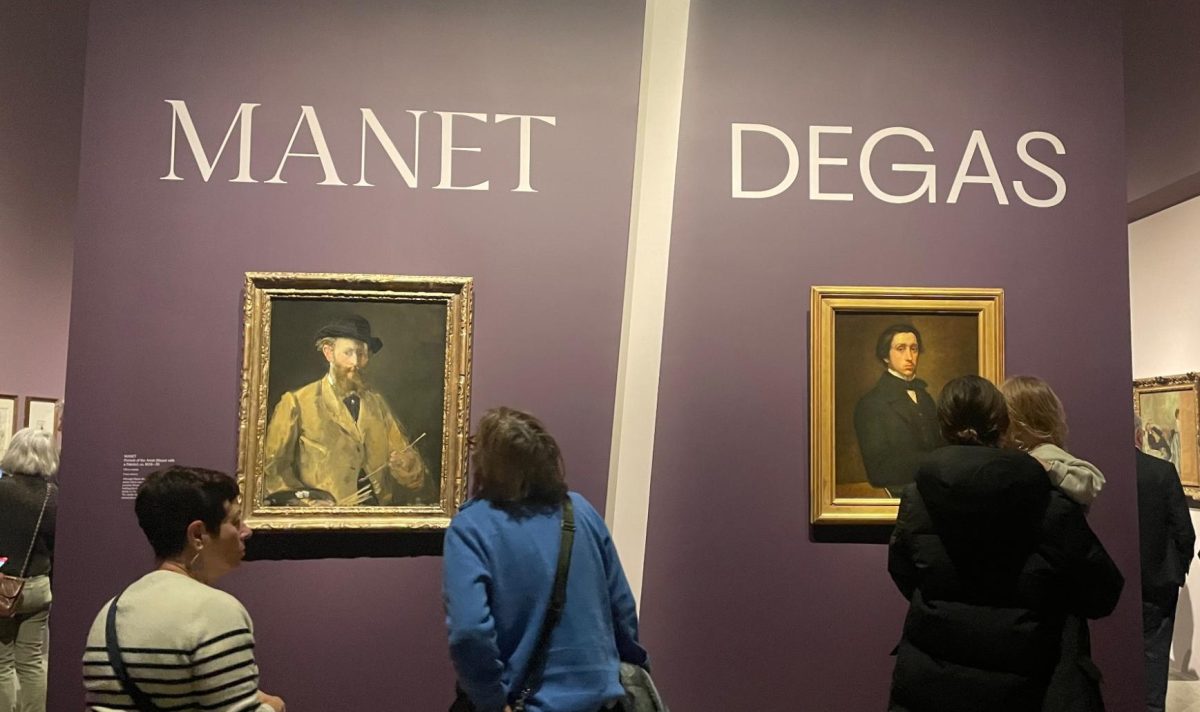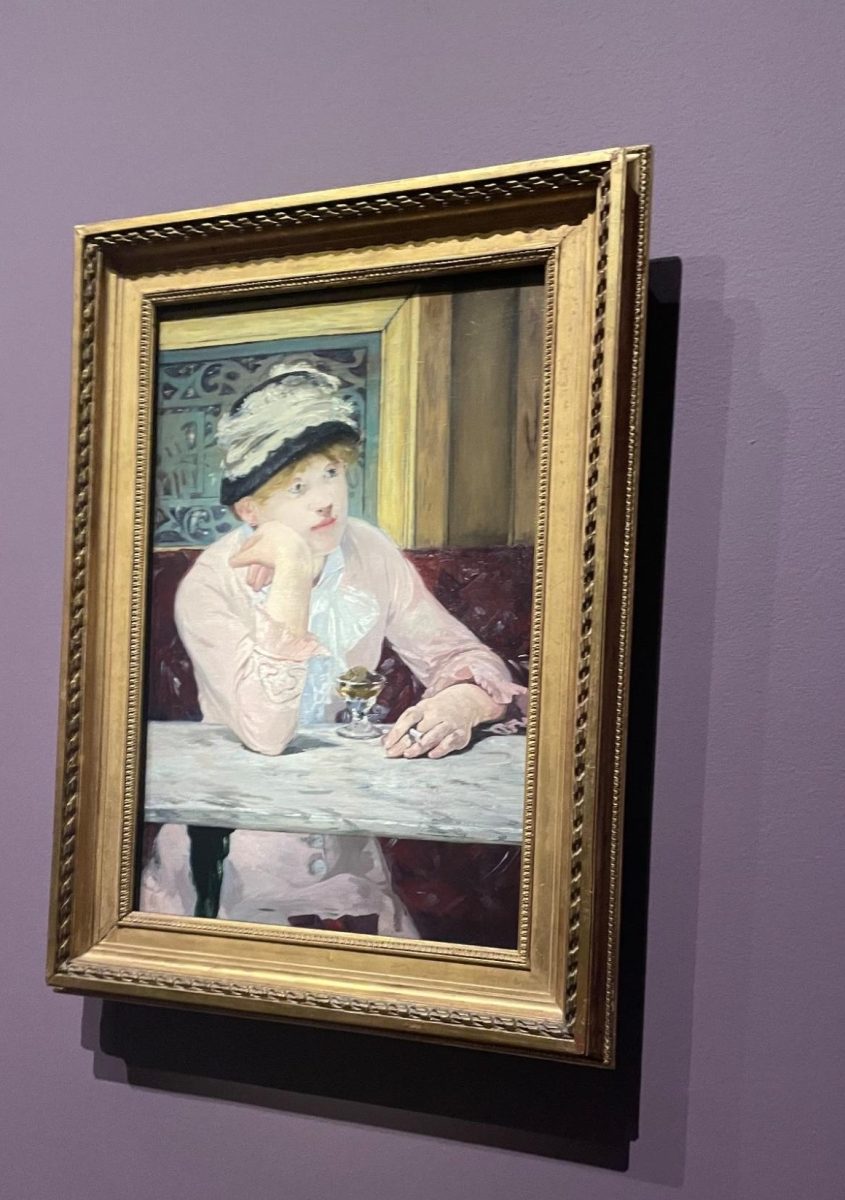On paper, Édouard Manet and Edgar Degas appear relatively similar. Both were born into the Parisian upper-class and deviated from familial expectations to become artists. Both forwent formal artistic training, and instead worked to develop the style known today as modern art through years of painstaking trial and error.
Manet/Degas, the newest powerhouse exhibition at the MET through January 7th, 2024, makes sure to highlight these similarities, while simultaneously bringing out the artists’ stylistic deviations. The show is almost interactive, a tale of rivalry and admiration, mutual respect and tentative homage. Instead of just an elaborate display of art, the exhibition functions as a sort of haunted love story.
Manet and Degas first met in the early 1860s, crossing paths while copying a Velázquez painting at the Louvre. Manet was older than Degas, and more successful. He was already getting recognition for several of his masterpieces: Olympia, The Spanish Singer and Dejeuner sur L’herbe. Degas, meanwhile, was only just starting to attract attention.
They were united in their distaste for traditional impressionism and younger artistic movements, and yet their professional similarities were not the sole reason for their friendship. Both artists were fiercely patriotic, determined to fight for their country and exemplify its strength through their work. They shared a mutual desire for greatness, constantly pushing each other towards artistic growth.
That fierce competition fostered a tumultuous relationship full of flaring tempers. One particularly ferocious debate ended with a Degas painting of Manet’s wife ripped in two by Manet. They simply had vastly different personalities. Manet was charming, likable, and outgoing, and loved giving interviews and sharing his work with the world. Degas, in contrast, was reclusive and hid from the spotlight.
But in the end, their mutual respect for one another won out. In response to news of Manet’s death in 1883, Degas declared that “he was greater than we thought,” and began to purchase much of Manet’s work. At the end of his life, it was estimated that Degas held over 80 paintings made by Manet.
It was a crisp Tuesday in early October 2023 when I, opting to take the number 4 instead of the usual B-D train, made my way to the MET after school. Even on a weekday, the museum was buzzing with people, a friendly mix of eager tourists and veteran visitors. Unsurprisingly, I was the only one with an oversized Jansport backpack and after waiting in line to purchase a ticket, I was finally allowed inside the exhibition.
What appeared first was unexpected, a slash of white across a beige wall with two names in bold, Manet and Degas, on either side. The font for Manet had a slight flair, eminent of his more refined public persona and outward personality. Degas’ in contrast, was blocky and clear cut, devoid of distinctiveness.
Below the names lay a self portrait by each respective artist. While Manet only painted two self portraits in his lifetime, Degas painted over 20, and yet it is Degas that looks uncomfortable in his picture, stiff and shrouded in darkness. Meanwhile, Manet, holding a paintbrush, is bathed in light, eager to show off his craft to the viewer.
The exhibit has no “Manet” or “Degas” specific area. Rather, each artist’s paintings are intermixed chronologically, allowing the viewer a unique side-by-side comparison of their painting styles and personalities. It is the equivalent of a plum-colored labyrinth, a sequence of thematic sections following the path of two careers irrevocably shaped by one another.
The exhibit starts in the tension filled section titled “An Enigmatic Relationship,” featuring representations of Manet’s wife Suzanne, both the defaced Degas depiction, M. and Mme Edouard Manet, and a strikingly similar rendering by Manet himself. The two compositions are set in the same place, Manet’s apartment on rue de Saint Petersbourg, and in both pieces, Suzanne is seated at the piano, a soft diagonal light just hitting her frame. Yet one painting is whole and the other ripped in two, a remnant of the heated argument between the artists, and a reminder of the fragility of their mutual affection.
Then, we are taken back to the artists’ emerging years: explorations to the Louvre and the National Library, inspections of paintings by respected artists of the era and treks to artistic wonders across Europe, all done to hone and develop their artistic craft.
Frequenting the same places prompted similar stylistic renderings. For example, a Degas depiction of one of Raphael’s nude figures served, decades later, as a model for the sprawled nude woman in Manet’s outrageous 1863 painting Déjeuner sur l’herbe. The original is at the Musée d’Orsay in Paris and too fragile to travel to this exhibition, but the painting is represented at the MET by an earlier draft version.
Debuting at the innovative Salon des Refusés, this groundbreaking piece helped to inaugurate a new style of painting, one encompassing the genres of still life, portraiture, and landscape. It is astonishing up close, a swirl of greens, browns, and yellows, all coming together to paint a portrait of indecency and upper class existence. Flanked by many of Manet’s other risqué paintings, it transforms the section into a hotbed of boundary breaking radicalism.
This bypass of traditional material is not unique. Throughout the exhibition there is a clear emphasis on Manet and Degas’ mutual transgression of traditional boundaries. One way is through their use of nudity; both artists subvert the traditional, idealized approaches to depicting the nude and instead make a point to display it with unabashed authenticity. This is shown in Degas’ composition Scene of War in the Middle Ages, a snapshot of a medieval battlefield, but more notably in Manet’s Olympia, his outrage-inducing, barrier-breaking mastery of a painting.
I had the privilege of viewing the composition this summer first at the Musee D’Orsay. There, the painting is framed by a blazing red background, almost invoking Hawthorne’s Scarlet Letter. The color serves as a sort of beacon, demanding attention towards the bored courtesan and everything she represents.
At the MET, it is the first time that this iconic painting has ever travelled to New York City. Here, against the uniform plum background, Olympia is not the focal point, but merely another painting progressing the narrative. Ironically, that almost makes it stand out more; the composition needs no color to attract attention, and it shows.
There are many sections of the exhibit, and the smaller ones take the time to highlight some of Manet and Degas’ more trivial fascinations, including Paris’ thriving café culture.
There, in the side-by-side placement of Degas’ In a Café (The Absinthe Drinker) and Manet’s Plum Brandy, is one of the gallery’s greatest pairings. You can see the true influence of one artist on another, for they practically painted the same figure, a lone woman at a café counter complete with a feathered hat and all. Yet this only further enables you to evaluate their critical stylistic deviations. While Degas’ figure is dour and dark, Manet’s is brimming with life.
The exhibition comes to a close with an unexpected section, entitled Degas after Manet. Here, we see how Degas honored Manet after his friend’s premature death, by assembling a personal collection of his work. Ultimately, Degas’s firm belief in the significance of Manet’s art overrode any animosity the pair shared.
At the start of the chronological exhibition, when Manet and Degas first met at the Louvre, Manet was by far the more well regarded artist, leaving Degas determined to surpass his level of prominence.
Yet at the end of the exhibit, we encounter a Degas secure enough in his own artistic ability to place their differences aside and tirelessly work to protect his friend’s legacy. This enables the viewer to leave the exhibition not simply aware of the transformation in Manet and Degas’ relationship, but also of the shift in Degas, from Manet’s second place to the artist’s torch-bearing legacy.
Manet/Degas is almost interactive, a tale of rivalry and admiration, mutual respect and tentative homage. Instead of just an elaborate display of art, the exhibition functions as a sort of haunted love story.


